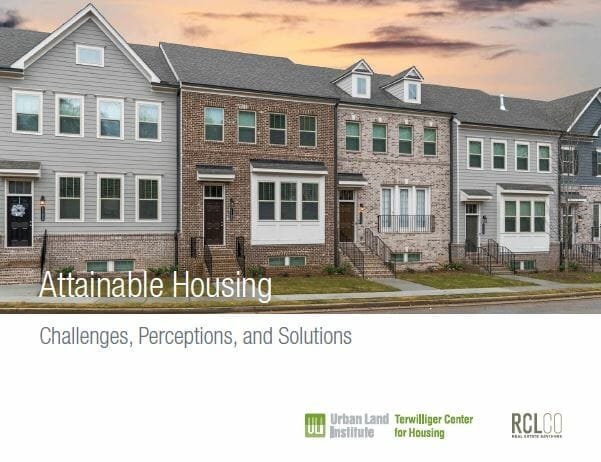Attainable Housing: Challenges, Perceptions and Solutions
 Launched at the ULI 2019 Spring Meeting in Nashville (see the slides form the presentation here), this new research from the Urban Land Institute explores the shortage of housing affordable to moderate-income home buyers – including first-time buyers — and solutions to increase the supply.
Launched at the ULI 2019 Spring Meeting in Nashville (see the slides form the presentation here), this new research from the Urban Land Institute explores the shortage of housing affordable to moderate-income home buyers – including first-time buyers — and solutions to increase the supply.
Attainable Housing: Challenges, Perceptions, and Solutions was prepared in coordination with with the Institute’s Terwilliger Center for Housing and RCLCO Real Estate Advisors. It is a study comprised of real estate economic data and two surveys: a national consumer preference survey, conducted by RCLCO, and a survey of ULI’s Community Development Council members.
The RCLCO survey found that consumers at all income levels value location and amenities more than large homes or lower-density housing. Although they want typical amenities such as a fitness center and trails, package receiving (for e-commerce) and nearby arts and culture activities are considered “very” or “somewhat” important, a finding that tracks closely with trends outlined in ULI’s latest Emerging Trends in Real Estate® report.
In the Community Development Council survey, members cited several challenges to delivery of attainable housing, including:
- The cost of capital;
- A lack of building efficiencies;
- Limited availability of buyer financing; and
- The high cost of materials.
The report finds that even though attainable housing represents as much as 60 percent of market demand in some markets, supply constraints are driving up prices on virtually all for-sale housing, and are causing lower cost, entry-level product to all but vanish. Larger, less affordable homes represent a growing share of the market and contribute to a lack of housing supply at lower price points. This trend of bigger homes with multiple bedrooms has coincided with a trend of decreasing household sizes, creating a growing g mismatch of product to demand, the report notes. Nearly 50 percent of delivered homes are four bedrooms or more, while less than 10 percent offer one and two bedrooms. Additionally, multifamily permits have shifted from for-sale products to products for rent.
The report provides several recommendations and strategies for increasing the affordable housing stock:
- Continual product innovation to improve offerings,
- Combining product types in developments,
- Lifestyle-choice messaging,
- Entitlement and design commitment, including retrofitting older homes and looking at how future land deals can provide multiple segments of attainable housing within neighborhoods to maximize absorption,
- Creating small homes or simplified versions of their core brand,
- More “missing-middle” attached housing, and
- Building more high-density detached (or cluster) housing.
“It is an important as ever for the industry to build all types of housing, and especially to find ways to build nonsubsidized housing for middle-class buyers,” says the report. “Ultimately, this type of housing – attainable housing – will relieve the current downward pressure on the market that has kept renters from becoming homeowners and has made housing increasingly unaffordable for Americans at lower income levels.”